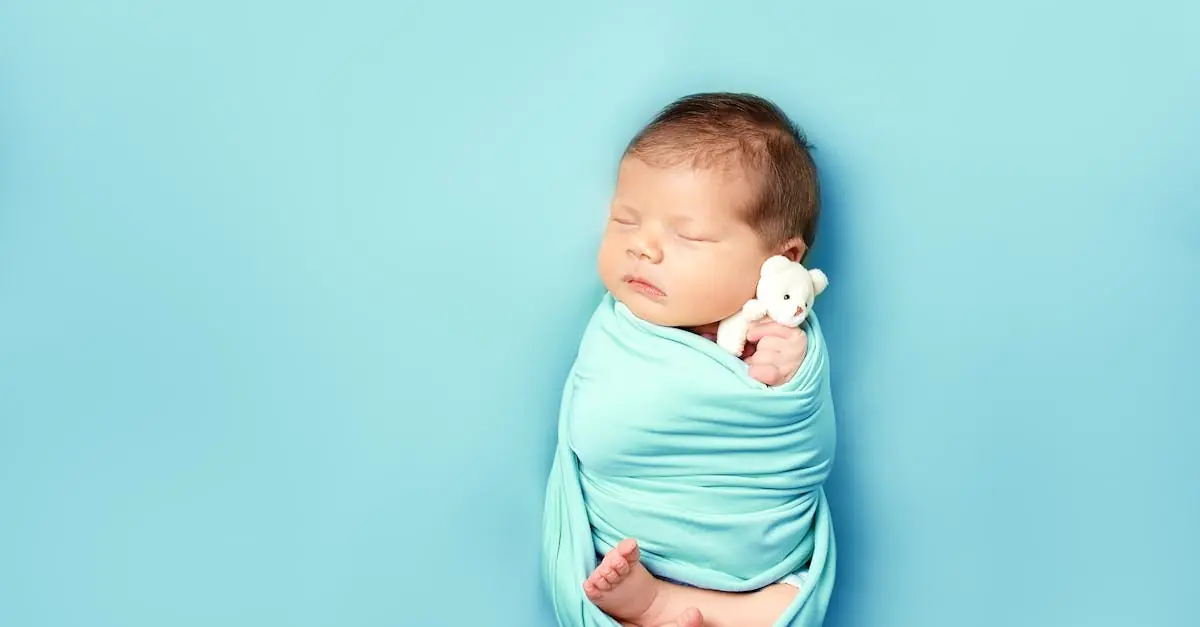Every parent knows that the crib is a magical place where babies transform into sleepy little angels. But as those tiny humans grow, the crib can start to feel more like a cozy prison. So when do babies finally break free from their crib confines?
Table of Contents
ToggleUnderstanding Crib Sleep Norms
Understanding crib sleep norms is vital for ensuring a smooth transition for babies as they grow. Parents often wonder when to move their child from a crib to a bed.
Developmental Milestones
Developmental milestones play a key role in determining when a baby should stop sleeping in a crib. Typically, children reach key movements, such as pulling up and climbing out of the crib, around 18 months to 3 years of age. Recognizing these milestones helps parents assess readiness. Signs like increased mobility and independence signal potential readiness for a toddler bed. Transitioning at the right time can prevent accidents and promote better sleep.
Sleep Patterns in Infants
Sleep patterns in infants significantly influence crib usage. Generally, infants sleep around 14 to 17 hours daily during their first year. As infants grow, sleep duration begins to decrease. By the age of two, average sleep amounts drop to 11 to 14 hours daily. Regular sleep patterns emerge around 6 months, with many babies starting to sleep through the night. Tracking these patterns aids in determining the right time for a crib transition. Understanding individual sleep needs serves as a helpful guide.
Factors Influencing Crib Transition
Several factors influence the decision to transition from a crib to a bed. Parents should consider their child’s age and size, alongside safety concerns.
Baby’s Age and Size
Baby’s age plays a crucial role in determining readiness for a bed. Typically, toddlers between 18 months and 3 years show signs that a crib no longer suits their needs. Size also matters; if a child begins to outgrow their crib, it signals that a transition might be necessary. Climbing out of the crib often occurs around these ages. When this happens, it’s important to act promptly, ensuring the child’s safety during sleep.
Safety Concerns
Safety concerns remain a top priority in the crib transition process. If a child frequently climbs out of the crib, potential injury increases. Cribs that no longer meet safety standards pose additional risks and may require upgrading. Parents must assess bedroom safety to prevent hazards associated with a toddler bed. Ensuring the new bed environment is safe fosters a seamless transition and promotes better sleep for both child and parents.
Signs It’s Time to Transition
Recognizing when to transition from a crib to a bed involves observing both physical indicators and behavioral changes in a child. Parents can monitor these signs to ensure a safe and seamless move.
Physical Indicators
Children often display physical signs that signal they need a different sleep environment. If a child consistently attempts to climb out of the crib, safety becomes a major concern. Increased height may also indicate that a crib no longer provides adequate space. When a child starts pulling up to a standing position or attempting to escape, transitioning to a toddler bed is advisable. Adults should remember that these indicators often occur between 18 months and 3 years.
Behavioral Changes
Behavioral shifts typically precede the need for a bed transition. Children may express discomfort or resistance to sleeping in their crib. Increased fussiness at bedtime often signals readiness for change. If a child frequently gets out of the crib during the night, it suggests they no longer feel secure in that space. Parents should pay attention to a child’s restlessness, as this can indicate a need for freedom and independence during sleep. Navigating these changes thoughtfully promotes a smoother transition for everyone involved.
Alternatives to Cribs
Parents often look for suitable alternatives as children transition from cribs. Recognizing safe and comfortable options plays a key role in this process.
Toddler Beds
Toddler beds serve as an excellent option for children ready to move on from cribs. These beds typically feature side rails, offering safety while promoting independence. Many toddler beds resemble regular beds but are lower to the ground, making it easier for kids to get in and out. Some beds come adorned with popular characters, making them appealing for little ones. Transitioning to a toddler bed supports growing toddlers’ autonomy while keeping safety in mind.
Floor Beds
Floor beds present another innovative alternative for toddlers. Placing a mattress directly on the floor allows for complete freedom of movement. This setup encourages children to explore their sleep space while minimizing risks associated with falling from higher beds. Parents appreciate the ease of access that floor beds offer, promoting a sense of security for little ones. Moreover, floor beds can double as play areas, making them versatile for various activities. Choosing a floor bed can foster creativity and comfort during the important transition from crib to bed.
Tips for a Smooth Transition
Making the transition from crib to bed can be a significant milestone for both child and parent. Implementing gradual changes helps children adjust comfortably.
Gradual Changes
Introducing changes slowly can ease the transition. Start by letting the child play in the new bed during the day. They’ll become familiar with the space. Spending time in the bed without pressure can reduce anxiety. Notably, parents can implement storytime in the new bed to create positive associations. Transitioning to a toddler bed or floor bed may also involve adjusting bedtime routines. Add comforting elements like favorite blankets or stuffed animals during this process. Observing the child’s response during these initial interactions can guide parents in further steps.
Creating a Comfortable Sleep Environment
Designing a peaceful sleep environment promotes better rest. Creating a consistent bedtime routine signals it’s time to wind down. Dim lights and soft sounds, such as lullabies, can enhance relaxation. In the child’s room, maintaining a cool temperature contributes to comfort. Personal touches, like colorful bedding and wall decor, can make the space inviting. Moreover, ensuring safety is crucial; removing hazards like sharp objects or heavy furniture encourages a secure atmosphere. A well-organized and cozy setting can significantly impact a child’s willingness to embrace the new bed.
Transitioning from a crib to a bed is a significant milestone for both children and parents. It’s essential to recognize the signs that indicate a child is ready for this change, such as climbing out of the crib or showing increased restlessness at bedtime. By paying attention to these cues and considering age and safety, parents can make informed decisions about the right time for the transition.
Choosing the right bed type can also enhance the experience. Toddler beds and floor beds offer safety and promote independence, making them ideal options. With gradual adjustments and a focus on creating a comforting sleep environment, parents can facilitate a smooth transition, ensuring their child feels secure and content in their new sleeping space.




